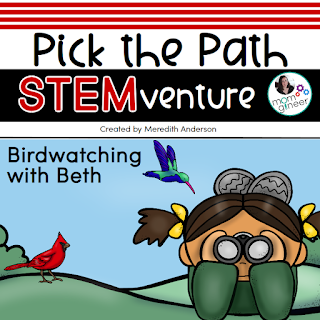STEM Activities for Elementary Students to explore Bird Beaks and Pollination
STEM That is Easy to Implement
This is the fifth installment of the “Pick the Path STEMventure” series. This story is about a budding ornithologist, Beth, as she visits a nature sanctuary and learns about various birds. Students decide how they want the story to progress; in completing the story students will complete 3-4 challenges. The story not only guides them through the engineering design process, it includes design constraints and areas for them to fill in their thoughts, plans, and testing data.
If you are studying animal adaptations, pollination, or even ecosystems, these are some engaging hands-on activities that your students will enjoy exploring!
Pollination STEM Challenge
Pollination is a concept that can be difficult for kids to understand. In this challenge, they will transfer “pollen” (which can be chalk dust, flour, etc.) from one flower to another.
A bonus in the resource I created is a page all about pollination. Students learn the basics and can color in the flower diagram to get a better idea of how plant reproduction takes place.
Another Bird Themed STEM Challenge – Eating
Do you know how hummingbirds eat? They don’t use their long beak like a straw, but use their tongues to lap up nectar much like a dog does. In this challenge, kids will have to try to grab the food at the bottom of a tube. They will be glad this isn’t a requirement for their own meals because it’s harder than it looks! The food can be anything that can be picked up, but I use pompoms. In addition to grabbing the item (such as with chopsticks), students can “hook” onto the food. If you are learning about magnets, you could absolutely work this in. Have the magnet be the food, and students will need to use an item in their “tongue” that is attracted to magnets in order to pick up the food.
My favorite challenge in this story explores wading birds and different types of beaks. Can you pick up the food but allow the water to drain out? Can you stab the food?
There are other types of bird beaks to explore as well, and this is a great time to talk about the food chain, the environment, and being a good Earth citizen. What would happen if a bird’s food supply goes away? Would they be able to adapt? Would their beak work well to eat another kind of food? These are big questions but I find most kids are ready to tackle them.
Find this STEM Resource on Teachers pay Teachers
If you would like to use the story and printables I’ve created, you can find them on Teachers pay Teachers at this link, Bird Beak STEM:
or save these ideas for later by pinning this on Pinterest:







